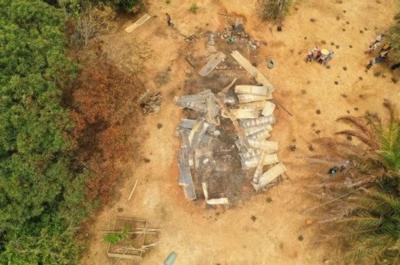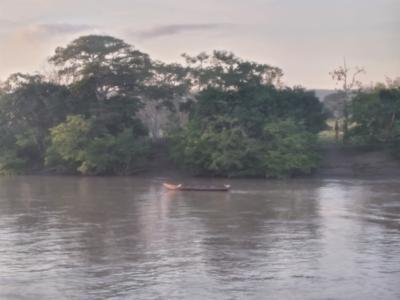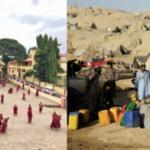Devastated jungle and dispossessed peasantry: military operations against deforestation that left peasant Colombians homeless in the Amazon region
A military operation to safeguard Colombia's environment heritage
In 2019, the government of Iván Duque launched the first military operation as part of the Artemis campaign against deforestation in the Cachicamo area, located in the Guaviare Department in northwestern Amazon, serving as a gateway to the Serranía del Chiribiquete National Natural Park. This initial operation had severe consequences, including the demolition of a rural dwelling, the burning of animals for domestic consumption, and the forced displacement of a small peasant family by the National Army. Former President Iván Duque emphasized that the primary objectives of this military operation were to safeguard Colombia's environmental heritage and protect this paradisiacal place, a unique and exclusive site declared UNESCO World Heritage. He also underscored the commitment to the national security strategy, sending a clear message that there would be no tolerance for deforestation. However, this military narrative is deeply intertwined with a long-standing pattern in the Colombian Amazon region: landless peasants, the expansion of agrarian frontiers, and historical militarization.
Military control is not a new experience for local communities and the region. Throughout the 2000s, this area was a central point in the implementation of various military plans, including the Plan Colombia, Plan Patriota, and the Integrated Consolidation Plan of La Macarena, all supported by the United States. Local communities endured fratricidal warfare and advanced military technology deployed to combat the communist guerrilla group FARC-EP and drug trafficking. In this context, one could argue that this region is characterized by what the scholar Rob Nixon has described as “slow violence,” a form of imperceptible harm dispersed over time and delayed in its spatial and long-term consequences, often escaping recognition as violence. Nevertheless, the region has been a center of both spectacular violence carried out by armed groups including the state and a slow violence manifested in the long-standing stigmatization as a violent, wild, and lawless territory.

During the government of Álvaro Uribe Vélez (2002-2010), the war on drugs intensified, and peasants had to endure the rain of glyphosate, the pesticide used for coca crop fumigation. As a result, thousands of peasants suffered health consequences, and in some cases, were displaced from their lands. In other instances, as part of the counterinsurgency plan against the FARC-EP, the peasantry was stigmatized by the National Army for living in an area under communist guerrilla control.
Civilian peasants as the new focus of military operations
However, after the intensification of the war and after 50 years of armed conflict, the FARC-EP laid down their arms as part of a political agreement with the government of Juan Manuel Santos (2010-2018). This peace agreement, which is also a state agreement, aims to provide land to the poorest peasants through a comprehensive reform of the rural sector. Nevertheless, during Iván Duque's government (2018-2022), land allocation progressed slowly, and, conversely, in the Amazon region, some priorities shifted towards controlling deforestation through militarization. This time, military operations against deforestation were no longer directed against the guerrilla but against civilian peasants. Regarded as illegal occupants in protected areas, Colombia's restrictive conservation measures have been part of public policy to limit peasant settlements in National Parks.
Despite these military strategies aimed at protecting National Natural Parks and buffer zones, deforestation increased from 2016 and persisted until 2022. In 2019, 158,894 hectares were lost due to deforestation, and in 2021, the figure rose to 174,102 hectares (Mongabay LATAM, 2023). Multiple factors contributed to this forest loss. On one hand, the departure of the FARC led to a change in local governance (Cealdes, 2023), and territorial control strategies weakened, as this armed actor, in agreement with communities, regulated the management of natural resources. This was partly because they required dense vegetation as refuge and cover in the jungle to evade military operations, and also due to local alliances with communities to protect natural resources and the forest. These alliances varied depending on the region, time, space, and the guerrilla's command structure in the area. Conservation of protected areas and the persecution of peasants became victims of these complex factors. Thus, deforestation emerges as a historical synthesis of these intricate elements, exacerbated by a regional political economy driven by speculation and land concentration by businesspersons, landowners, and large cattle ranchers, who have not been the target of these military operations to control deforestation.
Marijnen and Vermeijen (2016) have highlighted these operations in the context of "green militarization," in which the militarization of conservation is facilitated through practices and discourses that legitimize violent actions against local communities. In Virunga National Park in the Democratic Republic of the Congo, there has been significant continuity of colonial practices resulting in the marginalization of certain groups and invoking a state of emergency as a securitization mechanism. In Colombia, within the framework of Operation Artemis - and other military operations, for example, as part of the anti-drug policy - certain discourses portrayed the peasantry as responsible for deforestation and pollution. Meanwhile, institutional nature conservation is approached through commodification based on neoliberal principles, presenting the conservation of the National Natural Park as a private asset to attract large-scale tourism, with marketing strategies to exalt its majesty and unexplored nature.

Green militarization instilling terror among rural communities
A notable case has been Caño Cristales, a tourist destination in the Municipality of La Macarena promoted as "the river of seven colors" or "the most beautiful river in the world." While this conservation spectacle has been reinforced, two Artemis operations in the area targeted peasants who had lived in the region for at least 50 years, even before the media and tourism companies realized the splendor of this gem in this region. Another paradoxical aspect is that despite this municipality being a tourist destination because of Caño Cristales, its streets remain unpaved, and cell phone signal barely serves for sending messages. This clearly illustrates the daily challenges faced by people in areas where militarization persists, and social investment is limited.
Although the Artemis Military Operation was not on a large scale compared to previous military operations, it was effective in instilling terror among the rural population, as recounted by a relative of a peasant captured in an operation involving the Nasa Indigenous Community in the buffer zone of the Serranía del Chiribiquete National Natural Park, specifically in the Resguardo La Esperanza: "I was fishing when I heard the sound of a helicopter. I looked up at the sky, and they were flying overhead. After a while, we realized they were burning my brother's house. His son was crying inconsolably; they burned all of his belongings." His brother was arrested, and to this day, he remains in custody. At the time of the operation, there was no consideration for this community, whose members have been displaced and victimized multiple times by the FARC-EP and the National Army. They arrived in the buffer zone seeking land and with the intention of forming the reserve to obtain territorial rights. However, with this military operation, they were relocated to the urban center of San Vicente del Caguán in the department of Caquetá.
Thus, this military operation for deforestation control has multiple connections with the land issue in Colombia and global concerns about climate change. On one hand, thousands of families in the Colombian Amazon have come to this region in search of land or through government programs in the 1960s that promoted agrarian colonization as a way to address land concentration in productive areas. Instead of land expropriation, the government chose to promote peasant colonization in remote, jungle-covered areas with no infrastructure. Today, in some cases, relatives of those early settlers still remain in this region, awaiting land titles and guarantees of property rights that allow them to stay in the area with full land rights.
On the other hand, as concerns about rising global temperatures intensify, international agreements increasingly focus on developing countries. Issues such as climate change, pollution, and ongoing deforestation have led to an increase in foreign aid from developed nations. However, beyond military operations, the pressure of the fight against climate change adds additional pressure to the peasantry, who must deal with armed groups, state militarization, and limited state support. Countries like Norway, the United Kingdom, and Germany have been instrumental in financing the "fight against deforestation in the Amazon". Once again, it is the countries of the "Global North" that partly condition the funding, which should be part of an ethical reading of the current development model and shared and differentiated responsibilities regarding the ecological and social costs of the effects of climate change, as this phenomenon will affect not only the global economy but also the poorest social groups.
Currently, the government of Gustavo Petro has focused its efforts on fulfilling an ambitious campaign promise: implementing an agrarian reform that provides land to peasants in productive areas purchased directly from landowners and in line with climate justice. Another proposal from the government that has been put on the table is the forgiveness of external debt for middle and low-income countries to invest in climate change adaptation actions (MADS, 2023). However, these actions must be aimed at safeguarding the rights of local communities, without these multilateral agreements implying the expansion or establishment of protected areas that ignore the presence of peasants in these zones. If these actions are especially directed at strict conservation without addressing the land problem, once again, international actions and agreements will boomerang and perpetuate the violence that has characterized the Colombian Amazon region.
Reference list:
Cealdes. (2023). La deforestación en Colombia y sus alternativas: el eco de problemas jamás resueltos. Bogotá: Cealdes.
Marijnen, E & Verweijen, J. (2016). Selling green militarization: The discursive (re)production of militarized conservation in the Virunga National Park, Democratic Republic of the Congo. Geoforum 75, 274-285. https://doi.org/10.1016/j.geoforum.2016.08.003
Ministerio de Ambiente y Desarrollo Sostenible. (2023). En París, Colombia abanderó el canje de deuda por acción climática. https://www.minambiente.gov.co/en-paris-colombia-abandero-el-canje-de-deuda-por-accion-climatica/
Mongabay LATAM. (2023). Operation Artemis: Colombia’s failed military operation to stop deforestation. https://news.mongabay.com/2023/04/operation-artemis-colombias-failed-military-operation-to-stop-deforestation/
Nixon, Rob. (2011). Slow violence and the environmentalism of the poor. Harvard University Press: Cambridge, Massachusetts, and London, England.



![Engasjert antropologi i turbulente tider [Engaged Anthropology in Turbulent Times].](http://www.cmi.no/img/400/19475-Screenshot-2025-12-25-at-180604.png)
![Å holde flammen tent: Engasjert antropologi i mørke tider [Tending the flame: Engaged anthropology in dark times]](http://www.cmi.no/img/400/19474-Screenshot-2025-12-25-at-175845.png)
![Ti år med flyktningkriser og folkerettsbrudd i Europa (2015–2025): Kunne EU og Norge ha svart annerledes? [A Decade of Refugee Crises and Violations of International Law in Europe (2015-2025) – Could the EU and Norway Have Responded Differently?]](http://www.cmi.no/img/400/19473-Screenshot-2025-12-25-at-173706.png)



